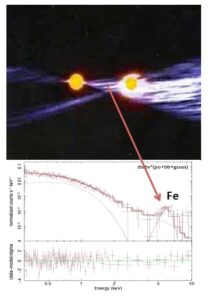It was well known that Sardinia was a land of mines and miners, but today, after the industry’s crisis, the search for metals remains only in history books. In the near future, however, the Sardinia Radio Telescope (SRT) could become a new “follow-up” tool (that is, to complete the monitoring of the source) for research programs on metals in distant stars from the Solar System. This is, in fact, the goal of the project by the National Institute of Astrophysics, which observed a binary pulsar system with XMM-Newton (X-ray Multi-Mirror), a satellite X-ray telescope. 
[In figure: In the top box, an artistic representation of the double pulsar. Below, the iron line identified with SRT. Credits: Iacolina, Pellizzoni, Egron et al., 2016, ApJ, 824, 87; Egron, Pellizzoni, Pollock et al., ApJ, in press]
Over 14 years after its discovery at radio frequencies by researchers at the INAF Astronomical Observatory of Cagliari, the double pulsar PSR J0737-3039 continues to amaze and remains the most extreme and compact among the rare binary systems with two neutron stars. Extreme because it allows for thorough testing of strong-field gravitational theories (like general relativity), and it’s the only case where signals are observed from two orbiting pulsars, separated by less than a million km (covered in 3 seconds at the speed of light, a trifle compared to typical cosmic distances). A much-studied astrophysical source, but one that can still hold interesting surprises, particularly in X-rays.
Two pulsars so close interact with each other, producing high-energy radiation, revealing interesting peculiarities of their structure, both in emission processes and in the surrounding environment. Thanks to monitoring through long observations over the years with the XMM-Newton satellite, it was understood how the brighter pulsar can activate the X emission of the slower and “lazy” companion pulsar, even when it is no longer observable in the radio band: it disappeared from the view of radio telescopes in 2008.
There seems to be a real energy transfer from one pulsar to the other even though there seems to be no transfer of matter. However, with great surprise, in the spectral analyses, an iron emission line at 6-7 keV (kilo-electronvolt, a unit of energy that multiplies a thousand volts by the charge of electrons) was found in the XMM-Newton data. This finding testifies to the presence of circumstellar material, perhaps linked to the remnants of an accretion disk that survived two supernova explosions that ended the lives of the progenitor stars of the two pulsars 50 to 200 million years ago. This emission, associated with the presence of iron, is typical of binary systems with neutron stars or black holes that accrete matter from a companion, but it was a process previously unknown in isolated or binary pulsars.
 The presence of this “iron mine,” this “archaeological relic,” reinforces speculations about similar structures that might be present in other peculiar neutron star systems that are not thought to accrete matter, providing valuable information about their past and their progenitors.
The presence of this “iron mine,” this “archaeological relic,” reinforces speculations about similar structures that might be present in other peculiar neutron star systems that are not thought to accrete matter, providing valuable information about their past and their progenitors.
The two articles describing these discoveries—one published in 2016, the other in the process of publication, both in ApJ—are authored by a team from the Astronomical Observatory of Cagliari, led by Alberto Pellizzoni and composed of astrophysicists Elise Egron from INAF and Maria Noemi Iacolina (now with ASI), both involved in the development and operations of the Sardinia Radio Telescope, the Sardinian radio telescope that will allow the continuation of monitoring the double pulsar in the coming years in the radio aspect.
[In figure, Noemi Iacolina (top) and Elise Egron (bottom), the two Cagliari researchers of the team responsible for the discovery]
“Without the ideas and the patient, long, and meticulous work of these researchers,” says Pellizzoni, “it would have been difficult to complete our observational project in the X band, which required, among other things, the adoption of innovative analysis techniques that combine spectral analysis and imaging, to confirm the actual presence of the iron line.”
To learn more:
Read the article “Long Term Study of the Double Pulsar J0737-3039 with XMM-Newton: pulsar timing,” by M. N. Iacolina, A. Pellizzoni, E. Egron, A. Possenti, R. Breton, M. Lyutikov, M. Kramer, M. Burgay, S. E. Motta, A. De Luca, and A. Tiengo
Read the article “Long-term study of the Double Pulsar J0737-3039 with XMM-Newton: spectral analysis,” by Elise Egron, Alberto Pellizzoni, Andy Pollock, Noemi Iacolina, Nazar Ikhsanov, Andrea Possenti, and Marco Marongiu